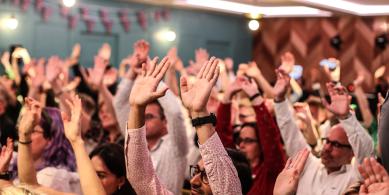Memphis, 1933
How and when five ducks first appeared in the lobby of the Peabody Hotel is not entirely clear. The hotel itself will tell you it all begins in the late hours of the Tennessee duck hunting season, one night in 1933. The General Manager has brought his live decoy ducks back with him to the hotel and, slightly over-refreshed from a day out with friends, decides to leave them in the interior fountain in the hotel lobby overnight to see what chaos he will awake to.
But if he’s hoping for outrage when he wakes up the next morning, the story goes, he is to be disappointed. Guests and staff alike love the ducks, and they stay; from that morning on, five of them have swum noisily and happily in the interior lobby fountain of the Peabody Hotel every day.
So, let’s choose to ignore the hotel postcards that show the ducks already swimming there eighteen years before this official story starts; every brand is entitled to a little myth-making, even in this post-truth world. Let’s focus on something else instead: the piece of drama that was added a little later, that turned the ducks – and the Peabody – from an interesting but forgettable novelty into a world-famous experience.
We cut to 1940.
The Peabody has a Bellman called Edward Pembroke. Pembroke hasn’t always been in hotels – he was previously an animal trainer in the circus. So he sees the ducks in the fountain not as an amusing quirk of the business, but as an under-leveraged opportunity. He thinks he could take what he’s learnt about creating spectacle and experience in the circus business, and bring it to the ducks. And to the hotel.
He approaches his superiors at the Peabody with an idea. Suppose the ducks weren’t just in the fountain all the time, he says; suppose I could make it a bit more interesting than that? What if I could train the ducks to come down in the hotel lift every morning from their duck house on the roof, parade across the lobby in front of the guests, and hop into the fountain? And, when it was time for them to go back up in the evening, train them to hop back out of the fountain, parade across the floor and into the lift again? We could create an actual spectacle out of this. Wouldn’t that be something?
The idea grew from there…
If you want to create an experience that people talk about, you have to give it a name. So they called it The Peabody Duck March. You have to give it some specificity and ritual. So the lift doors now open to let out the ducks at 11am every morning, and close behind them at 5pm every night. You have to create a feeling of sensory elevation. So the ducks waddle across a red carpet on their way to and from the lifts, to the rousing brass of a Sousa March. And, in perhaps the greatest stroke of experiential genius of all, between them they created an entirely new and unique job... The Duckmaster. Adopting the bright red coat and big voice of a circus ringmaster, Pembroke-as-Duckmaster started to announce the arrival and departure of the ducks in the lobby to guests and whoever else was there, morning and night. The idea had taken on a whole new level.
Almost 80 years later, the Duck March packs the lobby and first floor balcony of the Peabody twice a day, every day; if you’re not there 15 minutes early, you’re going to find yourself three or four rows back in a crowd of hotel guests, tourists and locals, most of them sharing that visual drama live on their phones with everyone they can. Even before social media the Peabody ducks proved a magnet for free television publicity for the hotel: they have marched across shows like Sesame Street, the sitcom Coach and Oprah. A more recent build on the idea has been to invite celebrities to be ‘Honorary Duckmasters’ for one of the daily marches, and those who’ve agreed to dress up in red and give it plenty have included Larry King, Kevin Bacon and politico-turned-railway-enthusiast Michael Portillo.
Which in turn attracts more coverage, of course – through the media news, the celebrities’ own postings and their fans’ sharing of it. And it’s not just the hotel that the fame of the ducks is keeping healthy. Memphis has had its ups and downs over the last 60 years, and the Peabody has not been immune to them, but as the downtown area of the city starts to gain altitude again, the success of the Peabody has been central to that broader renewal, too.
So, what’s the point?
It used to be that drama was a creative option for a brand that wanted to grow, but a choice that one left to the expertise and recommendation of the creative director. But we wonder if that’s true anymore. Perhaps, in a world of continuous partial attention, and three simultaneous screens, and looking-down-not-looking-up, drama has become a strategic imperative. Any challenger can only succeed by amplifying its differences - not in a continuous, exhausting wall-of-noise kind of way, but by selectively drawing attention to the differentiating characteristic about our brand that we really want people to notice. The wax dripping down the neck of the Maker’s Mark bottle announces ‘handcrafted’ more noticeably than any amount of advertising. Benefit’s flamboyantly playful packaging irresistibly draws your attention to both its product and unique point of view about cosmetics, whether you agree with them or not.
Elon Musk, the modern master of drama, has communicated what his brand stands for to the world with a series of signature moments of drama from naming (‘Ludicrous mode’) to symbols of re-evaluation (time trialled recharging vs ‘the fastest gas pump in LA’) to strapping a car on a rocket and blasting it into space. And who doesn’t desire a Tesla now? It’s become a strategic imperative today to be dramatic, and be clear on what your signature moment of drama is. And it has become a key capability for a challenger to understand how to dial up the drama in that moment or idea. People smile privately at ducks in a fountain, but they tell their friends about The Peabody Duck March. And we want and need people to tell their friends about us.
So let’s ask ourselves three simple questions:
1. Do we need to get ourselves noticed a little more than we are? Or even a lot more?
2. What single aspect of our brand or experience would we want to really draw attention to? That, if people noticed it, would really amplify what we believe makes us different?
3. How would Edward Pembroke elevate that moment into something that became multi-sensory, ritualised, genuinely dramatic?
Then look for people who understand circuses, and really put on a show. Wouldn’t that be something?
This piece is by Adam Morgan, founder of eatbigfish and The Challenger Project and first appeared here.
Adam's latest book 'A Beautiful Constraint: How to Transform Your Limitations Into Advantages', is out now.
Newsletter
Enjoy this? Get more.
Our monthly newsletter, The Edit, curates the very best of our latest content including articles, podcasts, video.
Become a member
Not a member yet?
Now it's time for you and your team to get involved. Get access to world-class events, exclusive publications, professional development, partner discounts and the chance to grow your network.




